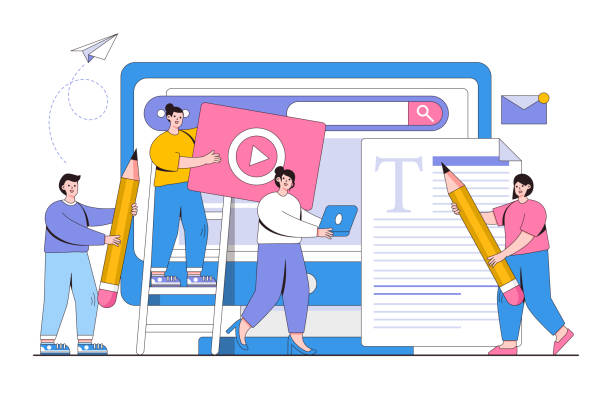The Unrivaled Importance of Speed in Website Design

#Speed #UserExperience #SEO In today’s digital world, where every second counts, fast website design is no longer considered an advantage, but a vital necessity.
Internet users have little patience, and according to research, if a website takes more than 3 seconds to load, a significant portion of visitors will abandon it.
This user abandonment not only leads to a sharp drop in conversion rates but also sends negative signals to search engines like Google, which can severely impact your SEO ranking.
A slow site directly negatively impacts user experience (UX) and can also tarnish your brand’s reputation.
This section provides an explanation of the importance of this topic and teaches you why you should consider optimizing your site speed.
Understanding these fundamental principles is essential for any business that wants to succeed in the online space.
Fast loading speed not only keeps visitors satisfied but also leads search engines to identify your website as a credible and user-friendly resource.
This is especially crucial for commercial and e-commerce websites, where every second of delay can mean lost sales.
Therefore, investing in fast website design is a smart and long-term strategy for online success.
Are you dissatisfied with the low visitor-to-customer conversion rate on your e-commerce site?
Solve this problem forever with professional e-commerce website design by Rasaweb!
✅ Increase visitor-to-customer conversion rate
✅ Create an excellent user experience and build customer trust
⚡ Get free consultation
Key Factors Affecting Website Loading Speed

#Influencing_Factors #Site_Architecture #Optimization Website loading speed is the result of a complex interplay of various factors, each of which can directly impact the final response time.
To achieve fast website design, understanding these factors and knowing how to manage them is crucial.
The first factor is the web hosting server; the type of host (shared, dedicated, VPS, or cloud), the server’s geographical location, and its hardware quality all play significant roles.
Optimized website coding, including HTML, CSS, and JavaScript, is also of high importance.
Excessive code, too many server requests, and improper use of JavaScript libraries can severely reduce speed.
In the technical part of this analysis, we will delve deeper into the role of web hosting and code architecture in fast website design.
Additionally, the size and number of media files such as images and videos, the use of web fonts, and the number of plugins or add-ons in content management systems (CMS) can also have a significant impact.
Even database configuration and query optimization play a role in the final speed.
In this analytical article, we help you gain a comprehensive understanding of these factors.
Optimizing each of these components individually and together can lead to a significant leap in your website’s loading speed and achieve the ultimate goal of a fast and efficient website design.
Optimizing Images and Media Files for Better Performance

#Images #Volume_Optimization #Quality One of the biggest obstacles to fast website design is the large size of images and media files.
These files usually constitute the heaviest part of a web page and can significantly increase loading time.
To achieve optimal speed, image optimization is a fundamental and essential guidance step.
This process includes compressing images without significant quality loss, choosing the appropriate format (such as WebP instead of JPEG or PNG for size reduction), and resizing images to their actual required dimensions on the website.
Using ‘Lazy Loading’ is also a very effective method; with this technique, images are loaded only when the user scrolls to the relevant section of the page, which significantly helps with faster initial page loading.
This specialized approach helps you manage your visual resources in a way that not only improves user experience but also significantly contributes to your fast and optimized website design.
| Format | Advantages | Disadvantages | Recommended Use for Speed |
|---|---|---|---|
| JPEG | Good compression for complex photos, wide support | No transparency support (Alpha Channel) | Photos and images with high detail |
| PNG | Transparency support, high quality without loss | High file size for complex photos | Logos, icons, images with transparent backgrounds |
| WebP | Very high compression with quality retention, transparency support | Less support in older browsers | Excellent alternative for JPEG and PNG, size optimization |
| SVG | Scalable vector graphics, very small size | Only suitable for vector graphics | Logos, icons, charts, and geometric shapes |
Additionally, using online image compression tools or CMS-specific plugins can be very useful in this process.
These minor but crucial actions are significant steps towards optimizing site speed and ensuring a smooth user experience.
Finally, regularly reviewing uploaded images and deleting unnecessary or large ones is also part of a specialized strategy for maintaining and ensuring fast website design.
The Role of Content Management Systems and Frameworks in Speed

#CMS #Framework #Code_Optimization Choosing the right Content Management System (CMS) or framework has a significant impact on fast website design.
Each of these platforms has its own advantages and disadvantages in terms of performance and speed.
For example, WordPress is a popular choice due to its flexibility and extensive plugin ecosystem, but excessive use of heavy plugins or unsuitable themes can severely reduce site speed.
This is an important technical point for developers and website administrators.
In contrast, frameworks like React, Vue, or Laravel give developers more control over the code and allow for building highly optimized and fast websites, but they require higher technical knowledge.
This explanatory section helps you gain a better understanding of the challenges and opportunities of each platform in the field of fast website design.
The thought-provoking content question here is: Does choosing a lighter framework always mean more speed? The answer is not necessarily yes.
A popular CMS like WordPress, with proper configuration, strong caching plugins, and database optimization, can be very fast.
The key is not just the platform choice, but how it is implemented and optimized.
For instance, in WordPress, choosing a lightweight and code-optimized theme and reducing the number of HTTP requests to the server are important principles of site speed optimization.
Also, using CSS and JavaScript management plugins to minify and combine files can dramatically reduce loading time.
Therefore, it’s important to evaluate project needs and the development team’s expertise before making a decision, then choose the best option to achieve a fast website design.
Do you dream of a thriving online store but don’t know where to start?
Rasaweb is your comprehensive e-commerce website design solution.
✅ Attractive and user-friendly design
✅ Increase sales and revenue⚡ Get free consultation
The Importance of Hosting and Content Delivery Network (CDN) in Site Performance

#Hosting #CDN #Server The foundation of any fast website design is choosing a suitable and powerful web hosting provider.
Server quality, allocated resources (like CPU and RAM), and even the geographical location of the data center can directly impact your website’s response time.
A slow or insufficient server, no matter how optimized your code is, can still severely reduce site speed.
In this specialized and guidance section, we examine different types of hosting and their role in increasing website speed.
Shared hosting is suitable for starting, but for high-traffic websites, VPS hosting, dedicated servers, or cloud hosting are recommended, as they guarantee more resources.
In addition to hosting, using a Content Delivery Network (CDN) is an excellent solution for optimizing site speed, especially for websites with a global audience.
CDN works by storing copies of static website files (such as images, CSS, and JavaScript) on multiple servers located in different geographical points (PoPs), ensuring that content is delivered from the server closest to the user.
This significantly reduces physical distance and minimizes loading time.
This is an analytical and strategic measure for fast website design on a global scale.
CDN not only increases speed but can also reduce the load on your main server and improve site security.
Choosing a reputable CDN and configuring it correctly will be an important step towards ensuring stable performance and fast website design for your website.
Advanced Code Optimization Techniques for Superior Performance

#Coding #JavaScript_Optimization #CSS Alongside content and infrastructure optimization, optimizing the basic website coding is one of the most specialized and effective ways to achieve fast website design.
This process involves several techniques that help reduce file size, the number of server requests, and improve resource loading methods.
The first step is Minification and Concatenation.
Minification refers to removing unnecessary spaces, new lines, and comments from HTML, CSS, and JavaScript files, which reduces file size.
Concatenation also means combining multiple small CSS or JavaScript files into one larger file to reduce the number of HTTP requests to the server.
This approach is considered essential guidance for developers.
Another technique is Asynchronous Loading for JavaScript and CSS.
By default, browsers pause page loading when encountering JavaScript and CSS files until these files are fully loaded and executed.
By using `async` and `defer` attributes for script tags and placing CSS in the `
This significantly contributes to fast website design.
These are detailed explanations of methods that can improve user experience.
Also, using Service Workers for resource caching and providing an offline experience, as well as using system fonts or optimizing web font loading, are other solutions for site speed optimization.
These measures, especially for complex websites, play a vital role in achieving a fast and responsive website design.
Intelligent Use of Caching and Gzip Compression

#Caching #Compression #Efficiency Caching is one of the most powerful tools available to web developers for achieving fast website design.
Caching allows the user’s browser or server to store copies of static website files (such as images, CSS, JavaScript, and HTML) so that they don’t need to be downloaded again from the server on subsequent visits.
This process significantly reduces page loading time for returning visitors and also lessens the load on the server.
This is an important educational principle for anyone looking to optimize site speed.
Caching can be performed at various levels: Browser Caching using HTTP headers, Server-Side Caching with tools like Redis or Memcached, and CMS-level Caching (like WordPress caching plugins).
In addition to caching, Gzip compression is also a vital technique for fast website design.
Gzip is a file compression format that allows the server to compress text files (such as HTML, CSS, and JavaScript) before sending them to the user’s browser.
This can reduce file sizes by 70% or more, meaning less data transfer over the network and faster page loading.
Most modern web servers (such as Apache and Nginx) have the capability to enable Gzip.
Enabling Gzip is a key guidance for increasing speed.
This combination of caching and compression are two main pillars in the strategy for fast website design and overall website efficiency improvement, offering users a more engaging and satisfying experience.
| Caching Type | Storage Location | Advantages | Primary Use |
|---|---|---|---|
| Browser Caching | User’s computer (browser) | Reduced server load, faster loading for returning visitors | Static files (images, CSS, JS) |
| Server-Side Caching | Web server | Reduced request processing time on the server | Dynamic page outputs, database queries |
| CDN Caching | CDN network’s Points of Presence (PoPs) | Fast content delivery from the closest server to the user | Static and sometimes dynamic files for global audiences |
| Database Caching | Server memory | Increased data retrieval speed from the database | Database-driven websites, CMSs |
Website Speed Measurement Tools and Result Analysis

#Speed_Tools #Performance_Test #Data_Analysis To ensure that your efforts for fast website design have paid off, you need to be able to accurately measure and analyze your website’s speed.
Fortunately, powerful tools exist for this purpose that provide you with specialized and useful information.
Google PageSpeed Insights, GTmetrix, and Pingdom Tools are among the most popular and comprehensive of these tools.
Each of these tools offers different metrics for evaluating website performance, including full page load time, Time to First Byte (TTFB), and performance scores based on best practices.
This section provides instruction on how to use and analyze the results of these tools.
Google PageSpeed Insights scores based on Google’s Core Web Vitals (LCP, FID, CLS) and provides recommendations for improvement.
GTmetrix provides more detailed reports on the Waterfall Chart, which shows when each resource was loaded and what potential issues might exist.
Pingdom Tools also provides an overview of global performance and loading times.
The important point in using these tools is to understand that no single tool is complete, and results should be analyzed together. This is an analytical step that helps you identify real problems.
For example, a low score in PageSpeed Insights might indicate JavaScript or CSS issues, while a long TTFB in GTmetrix could point to server or database problems.
Regularly using these tools and tracking changes after optimizations will help you continuously get closer to your fast website design and quickly follow up on any news of speed reduction.
Are you tired of your company’s website not being seen as it should be, losing potential customers? Solve this problem forever with professional and effective website design by Rasaweb!
✅ Increase brand credibility and build customer trust
✅ Attract targeted sales leads
⚡ Call us now for a free consultation!
The Close Relationship Between Site Speed and Search Engine Optimization (SEO)

#SEO #Ranking #Google_Algorithm Website speed and Search Engine Optimization (SEO) are inextricably linked.
Google, as the world’s largest search engine, has for years included page loading speed as an important ranking factor in its algorithms.
Websites that load faster provide a better user experience, which in turn causes Google to rank them higher in search results.
This is a technical and vital aspect of technical SEO.
Google’s introduction of Core Web Vitals, which operates based on real user experience metrics (such as Largest Contentful Paint, First Input Delay, and Cumulative Layout Shift), has further highlighted the importance of speed.
A slow website can lower your ranking in search results, even if you have excellent content.
This is important news for all webmasters and SEO specialists.
In addition to directly impacting ranking, website speed also indirectly affects SEO.
Faster websites have a lower bounce rate, meaning fewer users leave the site immediately after entering.
This indicates to Google that users are more satisfied with your site, which is a positive signal for ranking.
Also, faster sites enable Google’s crawlers to scan more pages in less time, which helps improve indexing and discovery of new content.
Therefore, any effort towards fast website design is effectively a direct investment in your website’s SEO and helps you stay ahead in online competition.
This is an analytical perspective that clarifies the importance of speed optimization from various angles.
Achieving a fast website design is essential not only for users but also for the future of your online presence.
Long-Term Strategies for Maintaining Sustainable Website Speed

#Maintenance #Updates #Sustainability Fast website design doesn’t just mean its initial launch, but also maintaining and sustaining that speed over time.
Websites are living entities that require regular maintenance and continuous updates.
Without these care, even the fastest websites will eventually slow down.
One of the most important strategies is regularly updating the Content Management System (CMS), themes, and plugins.
These updates often include performance and security enhancements that help maintain speed.
This is vital guidance for long-term performance maintenance.
In addition to updates, regular database cleanup is also essential.
Databases can become cluttered over time with redundant information, draft posts, spam comments, and unnecessary data, which can lead to slower queries and consequently, a sluggish site.
Database optimization tools can help clean and organize it.
The thought-provoking content question here is: Is it always necessary to install every new plugin or add-on? The answer is that you should be meticulous in choosing plugins and only install those you truly need, ensuring they are reputable and optimized.
Too many low-quality plugins can be speed killers.
Continuous monitoring with speed testing tools and quick response to any speed drops are also part of this strategy.
These actions provide an analytical and specialized approach to maintaining site speed optimization in the long term, ensuring that your fast website design remains a sustainable asset.
Frequently Asked Questions
| Question | Answer |
|---|---|
| What is fast website design? | The process of building a website that loads quickly and provides a smooth user experience. |
| Why is website speed important? | Improved user experience, reduced bounce rate, increased conversion rates, and better search engine rankings (SEO). |
| What factors affect website speed? | Image size, number of HTTP requests, code optimization (HTML, CSS, JS), hosting speed, and browser caching. |
| How can website speed be improved? | Optimizing images, compressing files, using caching, choosing suitable hosting, and reducing unnecessary plugins. |
| How do images affect website speed? | Large images or those in unsuitable formats can significantly increase page loading time. |
| What is the role of JavaScript and CSS in website speed? | Unoptimized, large, or blocking code execution can reduce page rendering speed. |
| How much does hosting affect website speed? | The speed and quality of the hosting server directly impact website response time and initial loading speed. |
| What tools are available to check website speed? | Google PageSpeed Insights, GTmetrix, Pingdom Tools are common tools. |
| What are the benefits of a fast website? | Greater user satisfaction, reduced bounce rate, increased time on site, and improved Google search rankings (SEO). |
| What are common mistakes that slow down a website? | Using unoptimized images, bulky and messy code, excessive use of plugins, and not using caching. |
And other services of Rasaweb Advertising Agency in the field of advertising
Smart Digital Advertising: Transform sales by customizing user experience.
Smart Customer Journey Mapping: A blend of creativity and technology for digital branding through key page optimization.
Smart Advertising Campaign: A professional solution for digital branding with a focus on intelligent data analysis.
Smart Conversion Rate Optimization: A dedicated service for growth in customer acquisition based on user experience customization.
Smart Website Development: Revolutionize customer acquisition with marketing automation.
And over hundreds of other services in the field of internet advertising, advertising consultation, and organizational solutions.
Internet Advertising | Advertising Strategy | Advertorial
Resources
Fast Website Design Articles
Site Optimization for Success
Complete Web Design Guide
Important Tips for Online Success
📍 Rasaweb Afarin Digital Marketing Agency specializes in providing comprehensive digital solutions for your business. From SEO strategies and content marketing to advanced e-commerce website design and targeted advertising campaigns, we transform your online presence.
📍 Tehran, Mirdamad Street, next to Bank Markazi, Kazeroon South Alley, Ramin Alley, No. 6




